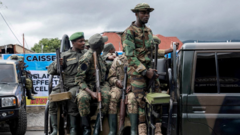Amidst the chaos of Myanmar's civil war, new armed resistance groups are capturing thousands of prisoners of war while the military junta takes few captive. Conditions in makeshift camps are challenging as rebels strive to provide for their prisoners.
Myanmar's Civil War: A Glimpse into the Treatment of Prisoners of War

Myanmar's Civil War: A Glimpse into the Treatment of Prisoners of War
The ongoing conflict in Myanmar has resulted in significant detailed accounts of how prisoners of war are managed by emerging rebel forces.
Tens of thousands of citizens in Myanmar have taken up arms against the military junta following a coup over four years ago, with many joining established armed factions or forming new rebel groups. Since the surge of resistance in 2023, these rebel forces have claimed series of decisive victories, resulting in the detention of around 15,000 prisoners of war according to People’s Goal, an organization dedicated to aiding military defectors. This cohort includes not just combatants but also family members of soldiers who were residing on military installations overtaken by resistance fighters.
The treatment of these prisoners of war has raised questions, particularly regarding the capacity of the various resistance factions, which operate with limited resources. Many of the groups maintain makeshift detention facilities scattered across the regions they control. The diversity in the size and structure of these camps means that while some may host a handful of detainees, others may accommodate hundreds.
Living conditions in these camps are reportedly challenging. In a bid for sustainability, prisoners often engage in agricultural activities and prepare their own meals, reflecting the necessity for rebellion groups to manage resources meticulously while navigating the complexities of providing for their incarcerated comrades. The dynamic of power in Myanmar continues to evolve, with the treatment of prisoners presenting just one of many facets of this ongoing conflict.



















